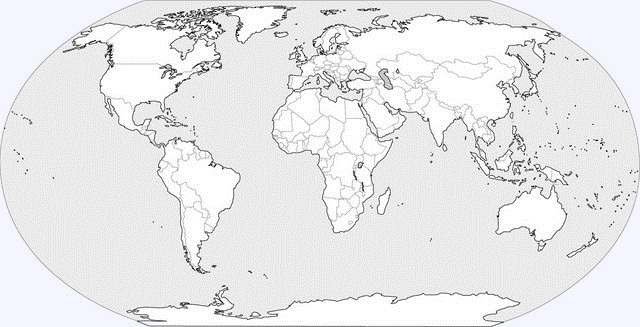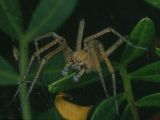|
Nombre común en ingles:
Wolf
spiders
Nombre común en castellano:
Se desconoce
Familias similares:
Género tipo:
Lycosa Latreille, 1804
Diagnosis:
Small to very large araneomorph
spiders; three tarsal claws; ecribellate; entelegyne; eyes in three
rows (4:2:2); male palp almost always without retrolateral tibial
apophysis; female carries egg-sac attached to spinnerets.
Caracteres descriptivos:
Caparazón:
longer than wide, narrower and higher in cephalic region; fovea
elongated; carapace covered with dense setae. Esternón:
oval, to scutiform. Ojos: eight; in three rows (4:2:2); all
dark in colour; unequal in size; anterior row with four small eyes;
second row with two large eyes and third row with two eyes of
intermediate size situated on anterolateral surface of carapace;
secondary eyes with grate-shaped tapetum. Quelíceros: strong,
with toothed cheliceral furrow; condyle prominent. Piezas bucales:
labium as wide as long, half the lengh of endites. Patas:
three claws; legs usually with scopula and spines; trochanters
notched. Abdomen: oval; covered with dense setae. Hileras:
six; colulus absent; in females with a pair of major ampullate gland
spigots and a pair of minor ampullate gland spigots on resp.
anterior lateral and posterior median spinnerets; the secondary
spigots are retained in connection with the attachment of the egg
cocoon. Sistema respiratorio:
two booklungs; one pair of tubular trachea; tracheal spiracle close
to spinnerets. Genitalia: entelegyne; epigyne with
well-sclerotized median septum, often in the shape of an inverted T;
male; palp without tibial apophyses (except Allocosa
tuberculipalpa, with large retrolateral tibial apophysis);
embolus variable in size and insertion. Tamaño corporal:
3-45 mm. Hogna ingeus (Blackwall, 1857) is one of the largest
Araneomorphae. Color: cryptic, ranging from dull yellowish
brown to grey or almost black with broad band over cephalothorax;
dorsum usually with pattern.
Estatus taxonómico:
The lycosids form part of the superfamily Lycosoidea based on the
specialized structure of the tapetum of the lateral and posterior
eyes (Coddington & Levi, 1991; Coddington et al., 2004). Griswold
(1993) discussed the phylogenetic arrangement of the Lycosoidea and
found the Lycosidae to be sister to Trechaleidae with which they
form the sister-group of the Pisauridae. The limits of subfamilies
and genera within the lycosids are far from clear (Alderweireldt,
1991; Vink et al., 2002).
Distribución: mundial.

Estilo de vida: Most
lycosids are free-living ground-dwelling hunters and are supposed to
have coevolved with grasslands. Some live in burrow or make sheet
webs provided with a funnel. Egg cocoons are carried, attached to
the spinnerets, and spiderlings spend the first days or weeks of
their existence on the abdomen of the mother.
Bibliografía:
-
Alderweireldt, M.
1991. A revision of the African representatives of the wolf spider
genus Evippa Simon, 1882 (Araneae, Lycosidae) with notes on allied
species and genera. J. nat. Hist. 25: 359-381.
-
Dippenaar-Schoeman, A.S. & Jocqué,
R. 1997. African Spiders: An Identification Manual. Plant Protection
Res. Inst. Handbook, no. 9, Pretoria, 392 pp.
-
Dondale, C.D. 2005a.
Lycosidae. pp. 164-172 in Ubick, D., Paquin, P., Cushing, P.E. &
Roth, V. (Eds) 2005. The Spiders of North America. An Identification
Manual. American Arachnological Society.
-
Griswold, C.E. 1993.
Investigations into the phylogeny of the lycosid spiders and their
kin (Arachnida: Araneae: Lycosoidea). Smithson. Contrib. Zool. 539:
1-39.
-
Vink, C.J. 2002.
Lycosidae (Arachnida: Araneae). Fauna of New Zealand 44: 1-94.
-
Vink, C.J.,
Mitchell, A.D. & Paterson, A.M. 2002. A Preliminary molecular
analysis of phylogenetic relationships of Australasian wolf spider
genera (Araneae, Lycosidae). J. Arachnol. 30: 227-237.
18 géneros y 92 especies presentes en la Península Ibérica:
|
| |
- A.
dufouri
(Simon, 1876) |
| |
- A. fasciventris
(Dufour, 1835) |
|
| |
- A. accentuata
(Latreille, 1817) |
| |
- A. albofasciata
(Brullé, 1832) |
| |
- A. alpicola
(Simon, 1876) |
| |
- A. barbipes
(Sundevall, 1833) |
| |
- A. cuneata
(Clerck, 1757) |
| |
- A. cursor
(Hahn, 1831) |
| |
- A. laciniosa
(Simon, 1876) |
| |
- A. osellai
Lugetti & Tongiorgi, 1969 |
| |
- A. pulverulenta
(Clerck, 1757) |
| |
- A. simoni
(Thorell, 1872) |
| |
- A. sulzeri
(Pavesi, 1873) |
| |
- A. trabalis
(Clerck, 1757) |
|
| |
- A. perpicax
(L. Koch, 1882) |
|
| |
- A. cinerea
(Fabricius, 1777) |
| |
- A. excellens
(Simon, 1876) |
| |
- A. figurata
(Simon, 1876) |
| |
- A. fulvolineata
(Lucas, 1846) |
| |
- A. lacustris
(Simon, 1876) |
| |
- A. leopardus
(Sundevall, 1833) |
| |
- A. letourneuxi
(Simon, 1885) |
| |
- A. maculata
(Hahn, 1822) |
| |
- A. misella
(L. Koch, 1882) |
| |
- A. perita
(Latreille, 1799) |
| |
- A. personata
(L. Koch, 1872) |
| |
- A. similis
Schenkel, 1938 |
| |
- A. variana
C. L. Koch, 1847 |
| |
- A. villica
(Lucas, 1846) |
|
| |
- A. albimana
(Walckenaer, 1805) |
|
| |
- D. merlini
Alderweireldt & Jocqué, 1991 |
|
| |
- H. balearica
(Thorell, 1873) |
| |
- H. ferox
(Lucas, 1838) |
| |
- H. fraissei
(L. Koch, 1882) |
| |
- H. hispanica
(Walckenaer, 1837) |
| |
- H. insulana
(L. Koch, 1882) |
| |
- H. radiata
(Latreille, 1817) |
|
| |
- H. rubrofasciata
(Ohlert, 1865) |
|
| |
- L. ambigua
Barrientos, 2004 |
| |
- L. narbonensis
Walckenaer, 1806 |
| |
- L. tarantula
(Linnaeus, 1758) |
|
| |
- P. agricola
(Thorell, 1856) |
| |
- P. amentata
(Clerck, 1757) |
| |
- P. bifasciata
(C. L. Koch, 1834) |
| |
- P. blanda
(C. L. Koch, 1833) |
| |
- P. cribrata
Simon, 1876 |
| |
- P. femoralis
Simon, 1876 |
| |
- P. gefsana
Roewer, 1959 |
| |
- P. hortensis
(Thorell, 1872) |
| |
- P. italica
Tongiorgi, 1966 |
| |
- P. luctinosa
Simon, 1876 |
| |
- P. lugubris
(Walckenaer, 1802) |
| |
- P. monticola
(Clerck, 1757) |
| |
- P. morosa
(L. Koch, 1870) |
| |
- P. nigriceps
(Thorell, 1856) |
| |
- P. occidentalis
Simon, 1881 |
| |
- P. oreophila
Simon, 1937 |
| |
- P. paludicola
(Clerck, 1757) |
| |
- P. palustris
(Linnaeus, 1758) |
| |
- P. prativaga
(L. Koch, 1870) |
| |
- P. proxima
(C. L. Koch, 1847) |
| |
- P. pseudostrigillata
Tongiorgi, 1966 |
| |
- P. pullata
(Clerck, 1757 |
| |
- P. pyrenaica
Kronestedt, 2007 |
| |
- P. riparia
(C. L. Koch, 1833) |
| |
- P. saltuaria
(L. Koch, 1870) |
| |
- P. saturatior
Simon, 1937 |
| |
- P. tatarica
(Thorell, 1875) |
| |
- P. tenuipes
L. Koch, 1882 |
| |
- P. torrentum
Simon, 1876 |
| |
- P. vittata
(Keyserling, 1863) |
| |
- P. wagleri
(Hahn, 1822) |
|
| |
- P. piraticus
(Clerck, 1757) |
| |
- P. simplex
(L. Koch, 1882) |
| |
- P. tenuitarsis
Simon, 1876 |
| |
- P. uliginosus
(Thorell, 1856) |
|
| |
- P. hygrophila
(Thorell, 1872) |
| |
- P. latitans
(Blackwall, 1841) |
|
| |
- P. pyrenaea
(Simon, 1876) |
| |
- P. rupicola
(Dufour, 1821) |
| |
- P. spinosa
(Denis, 1938) |
|
| |
- T. cazorla
Snazell, 1983 |
| |
- T. paradoxa
Simon, 1876 |
|
| |
- T. hispanica
Simon, 1870 |
| |
- T. ochracea
(L. Koch, 1856) |
| |
- T. robusta
(Simon, 1876) |
| |
- T. ruricola
(De Geer, 1778) |
| |
- T. terricola
Thorell, 1856 |
|
| |
- T. conspersa
(L. Koch, 1882) |
|
| |
- W. fidelis
(O. P.-Cambridge, 1872) |
|
| |
- X. miniata
(C. L. Koch, 1834) |
| |
- X. nemoralis
(Westring, 1861) |
| |
|
 |